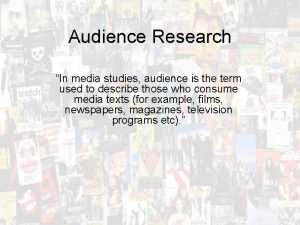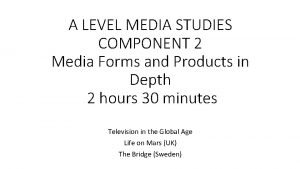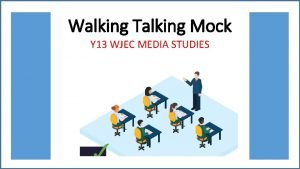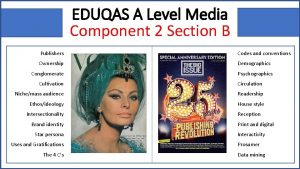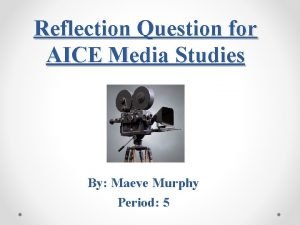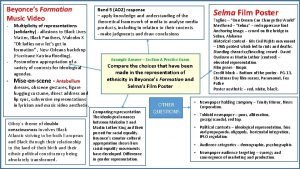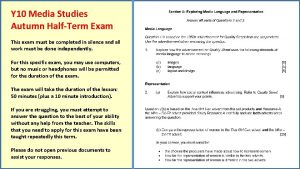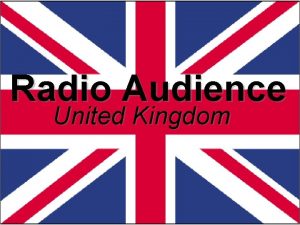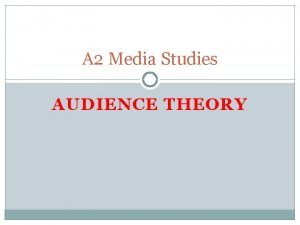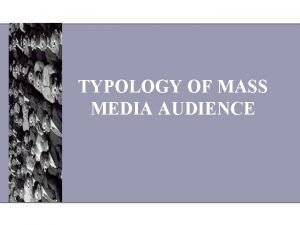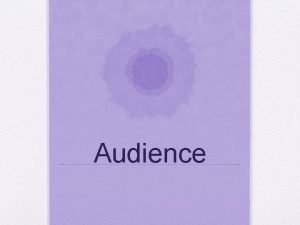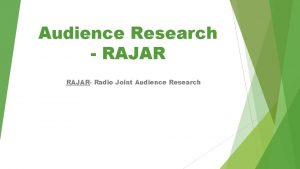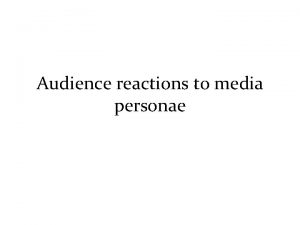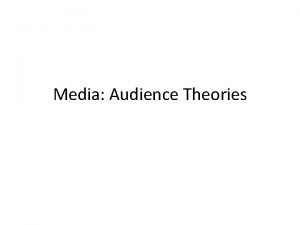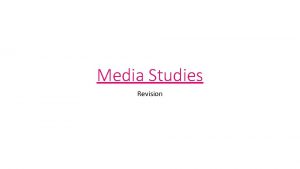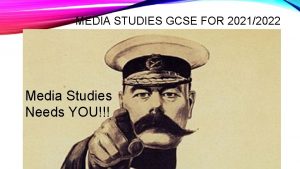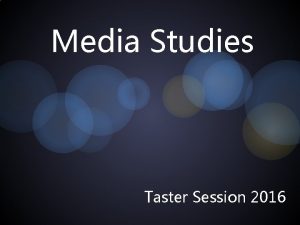Audience Research In media studies audience is the













- Slides: 13

Audience Research “In media studies, audience is the term used to describe those who consume media texts (for example, films, newspapers, magazines, television programs etc). ”

Audience Profiling • Audiences may be identified and categorised in different ways: • • Age Gender Ethnicity Social grade (socio economic) E. g. Education/Occupation/ Income • Psychographics (Values, attitudes and lifestyles/VAL’s) Other things to consider: • Disposable Income • Current and Desire Lifestyle • Buying Habits • Other Media Interests • Loyalty to Brands • Political Affiliation • Religion • Sexuality • This is known as demographics. It allows media producers to target the right group of people.

Socio-economic classification

Audience Research; What other ways can you divide audiences? • Psychographic profiling is designed to test audience responses by attitude. Based on the ‘inner qualities’ of a person. For example, a questionnaire would be sent to targeted sections of the population with questions to respond to such as “on a scale of 1 -5, with 1 representing “strongly agree” and 5 representing “strongly disagree”, respond to the following statements: “A woman’s place is in the home……. ” etc. • • • personality lifestyle values activities interests opinions

Audience Research; What other ways can you divide audiences? • Psychographic profiling continued (Selby & Cowdery 1995: 25) • Psychographic variables often relate to the aspirations of the consumer – the type of person they would like to be, for example… • Aspirational types found in younger audiences: • Trendies – those who crave the attention of their peers • Egoists – those who seek pleasure • Puritans – those who wish to feel virtuous • Innovators – those who wish to make their mark • Rebels – those who wish to remake the world in their image • Groupies – those who just want to be accepted • Drifters – those who are not sure what they want • Drop-outs – those who shun commitment of any kind • Traditionalists – those who want things to stay as they are • Utopians – those who want the world to be a better place • Cynics – those who have something to complain about • Cowboys – those who want to earn easy money Name 4 media texts aimed at 4 psychographic profiles, e. g. The Daily Mail is aimed at traditionalists because…

Audience Segmentation (advertising agency Young and Rubicam) • Mainstreamers – make up about 40% of the population. They conform to the dominant ideology, more or less. They like security, follow set patterns of work and leisure and enjoy a sense of belonging. They are jogging along quite nicely, financially, but are not high-flyers. • Succeeders – People who have already got status and control and are high earners, at or near the top of their field. They are affluent and comfortable. • Aspirers – people who desire status, success and the esteem of others. They are ambitious and like status symbols, such as designer labels and expensive items such as impressive cars, jewellery, etc. They aspire to be wealthy and influential. • Reformers – people who are less selfishly motivated and believe in making a difference to the world they live in. They define themselves by self-fulfilment and self-esteem. Likely to be in the caring professions. • Which category would you fall into? What about your classmates?

Mode of Address • ‘Mode of address’ refers to the way in which a media text ‘speaks’ to it’s target audience in order to encourage them to identify with it. • Newspapers often construct their presentation to reflect what they imagine is the typical identity of their readers.

Mode of Address • The way a media text ‘speaks to’ its audience can depend on various assumptions the producers make about the people watching; • What type of people are they e. g. old, young, etc. ? • Who does the text want to attract? • What is the relationship between the audience and text – e. g. is the programme intended to be funny, serious, informative, emotionally moving, etc. ? Furthermore, the mode of address it uses may lead audience members to assume a particular attitude towards the text, such as paying attention, taking it seriously or light-hearted entertainment.

The Sun’s Target Audience • Male - heavy coverage of sport, particularly football; page 3 and other “sexist” portrayals of women). There is some content that is ‘woman friendly’ (celebrity content). • 16+ - simplistic coverage, celebrity content, titillating stories. • White British– possible negative representations of ethnic minorities, xenophobic? or nationalistic attitude? Patriotic stories. • Working Class/C 2 DE – price (40 p), very little serious political coverage, focus on show business/sensational stories, 20%of the paper about sport with an emphasis on football, the size is convenient. • Fairly right wing political views (political content). • Value and Attitudes: ‘Mainstreamers’, ‘Strugglers’ and ‘Resigned’. Illustrated through advertising.

The Sun’s Target Audience • Male - heavy coverage of sport, particularly football; page 3 and other “sexist” portrayals of women). There is some content that is ‘woman friendly’ (celebrity content). • 16+ - simplistic coverage, celebrity content, titillating stories. • White British– possible negative representations of ethnic minorities, xenophobic? or nationalistic attitude? Patriotic stories. • Working Class/C 2 DE – price (40 p), very little serious political coverage, focus on show business/sensational stories, 20%of the paper about sport with an emphasis on football, the size is convenient. • Fairly right wing political views (political content). • Value and Attitudes: ‘Mainstreamers’, ‘Strugglers’ and ‘Resigned’. Illustrated through advertising. What mode of address do you think The Sun uses? How can you relate this to the target audience?

Readership and Circulation • http: //www. newsworks. org. uk/The-Sun • Average daily circulation for The Sun (print) in 2016 was 1, 722, 145. • Highest daily circulation in Britain. • Tagline – ‘For a greater Britain’.


Homework • Research a range of newspaper titles and analyse their audience figures – create a detailed audience profile on two other newspapers. • Choose one of these and analyse how the front cover attracts the specific target audience that you have identified.
 Audience psychographic research
Audience psychographic research Life on mars audience media studies
Life on mars audience media studies Examples of audience research in media
Examples of audience research in media Paradigm shift from women studies to gender studies
Paradigm shift from women studies to gender studies Audience addressed audience invoked
Audience addressed audience invoked Todorov narrative theory
Todorov narrative theory Media studies poster
Media studies poster Eduqas gcse media
Eduqas gcse media Vogue 1965 media studies
Vogue 1965 media studies Minecraft media studies
Minecraft media studies Aice media studies final project
Aice media studies final project Beyonce formation video analysis
Beyonce formation video analysis Quality street media studies
Quality street media studies Wjec media studies gcse
Wjec media studies gcse
